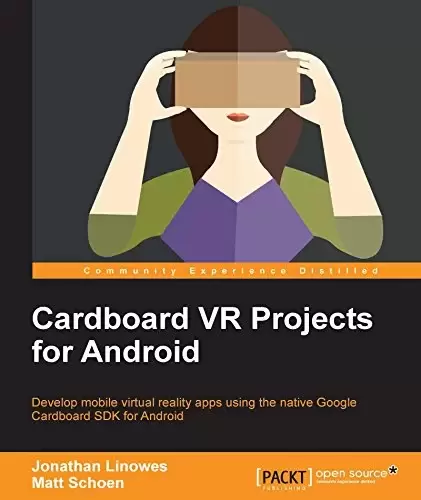
Book Description
Develop mobile virtual reality apps using the native Google Cardboard SDK for Android
About This Book
- Learn how to build practical applications for Google’s popular DIY VR headset
- Build a reusable VR graphics engine on top of the Cardboard Java SDK and OpenGL ES graphics libraries
- The projects in this book will showcase a different aspect of Cardboard development—from 3D rendering to handling user input
Who This Book Is For
The book is for established Android developers with a good knowledge level of Java. No prior OpenGL or graphics knowledge is required. No prior experience with Google Cardboard is expected, but those who are familiar with Cardboard and are looking for projects to expand their knowledge can also benefit from this book.
What You Will Learn
- Build Google Cardboard virtual reality applications
- Explore the ins and outs of the Cardboard SDK Java classes and interfaces, and apply them to practical VR projects
- Employ Android Studio, Android SDK, and the Java language in a straightforward manner
- Discover and use software development and Android best practices for mobile and Cardboard applications, including considerations for memory management and battery life
- Implement user interface techniques for menus and gaze-based selection within VR
- Utilize the science, psychology, mathematics, and technology behind virtual reality, especially those pertinent to mobile Cardboard VR experiences
- Understand Cardboard VR best practices including those promoted by Google Design Lab.
In Detail
Google Cardboard is a low-cost, entry-level media platform through which you can experience virtual reality and virtual 3D environments. Its applications are as broad and varied as mobile smartphone applications themselves. This book will educate you on the best practices and methodology needed to build effective, stable, and performant mobile VR applications.
In this book, we begin by defining virtual reality (VR) and how Google Cardboard fits into the larger VR and Android ecosystem. We introduce the underlying scientific and technical principles behind VR, including geometry, optics, rendering, and mobile software architecture. We start with a simple example app that ensures your environment is properly set up to write, build, and run the app. Then we develop a reusable VR graphics engine that you can build upon. And from then on, each chapter is a self-contained project where you will build an example from a different genre of application, including a 360 degree photo viewer, an educational simulation of our solar system, a 3D model viewer, and a music visualizer.
Given the recent updates that were rolled out at Google I/O 2016, the authors of Cardboard VR Projects for Android have collated some technical notes to help you execute the projects in this book with Google VR Cardboard Java SDK 0.8, released in May 2016. Refer to the article at https://www.packtpub.com/sites/default/files/downloads/GoogleVRUpdateGuideforCardbook.pdf which explains the updates to the source code of the projects.
Style and approach
This project based guide is written in a tutorial-style project format, where you will learn by doing. It is accompanied by in-depth explanations and discussions of various technologies, and provides best practices and techniques.
Table of Contents
Chapter 1. Virtual Reality for Everyone
Chapter 2. The Skeleton Cardboard Project
Chapter 3. Cardboard Box
Chapter 4. Launcher Lobby
Chapter 5. RenderBox Engine
Chapter 6. Solar System
Chapter 7. 360-Degree Gallery
Chapter 8. 3D Model Viewer
Chapter 9. Music Visualizer
中文:
书名:Cardboard VR Projects for Android
使用本地Google Cardboard SDK for Android开发移动虚拟现实应用程序
关于本书
- Learn how to build practical applications for Google’s popular DIY VR headset
- 在Cardboard Java SDK和OpenGL ES图形库的基础上构建可重用的VR图形引擎
- 本书中的项目将展示Cardboard开发的不同方面-从3D渲染到处理用户输入
这本书是为谁写的
这本书是为对Java有良好知识水平的Android开发人员编写的。不需要先前的OpenGL或图形知识。没有谷歌纸板之前的经验是预期的,但那些熟悉纸板,并正在寻找项目,以扩大他们的知识也可以受益于这本书。
你将学到什么
- 构建Google Cardboard虚拟现实应用程序
- 探索Cardboard SDK Java类和接口的细节,并将它们应用到实际的VR项目中
- 以简单的方式使用Android Studio、Android SDK和Java语言
- 发现并使用针对移动和纸板应用的软件开发和Android最佳实践,包括内存管理和电池续航方面的注意事项
- 在VR中实现用于菜单和基于凝视的选择的用户界面技术
- 利用虚拟现实背后的科学、心理学、数学和技术,特别是与移动纸板VR体验相关的那些
- 了解纸板VR的最佳实践,包括由谷歌设计实验室推广的实践。
In Detail
Google Cardboard是一个低成本的入门级媒体平台,您可以通过它体验虚拟现实和虚拟3D环境。它的应用程序和移动智能手机应用程序本身一样广泛和多样。这本书将教你构建有效、稳定和高性能的移动VR应用程序所需的最佳实践和方法。
在这本书中,我们首先定义虚拟现实(VR),以及Google Cardboard如何融入更大的VR和Android生态系统。我们介绍了VR背后的基本科学和技术原理,包括几何学、光学、渲染和移动软件架构。我们从一个简单的示例应用程序开始,该示例应用程序确保您的环境已正确设置以编写、构建和运行该应用程序。然后我们开发一个可重复使用的VR图形引擎,您可以在此基础上进行构建。从那时起,每一章都是一个独立的项目,你将从不同类型的应用程序中构建一个例子,包括360度照片查看器、我们太阳系的教育模拟、3D模型查看器和音乐可视化工具。
鉴于最近在Google I/O 2016上推出的更新,针对Android的Cardboard VR项目的作者整理了一些技术说明,以帮助您使用2016年5月发布的Google VR Cardboard Java SDK 0.8执行本书中的项目。请参考https://www.packtpub.com/sites/default/files/downloads/GoogleVRUpdateGuideforCardbook.pdf上的文章,其中解释了对项目源代码的更新。
风格和方法
这本基于项目的指南是以教程风格的项目格式编写的,您将在实践中学习。它伴随着对各种技术的深入解释和讨论,并提供了最佳实践和技术。
目录表
第1章:面向所有人的虚拟现实
第二章.骨架纸板项目
第三章.纸板箱
第四章.发射大堂
第5章.RenderBox引擎
Chapter 6. Solar System
第七章:360度画廊
第8章:3D模型查看器
第九章:音乐展示台
评论前必须登录!
注册